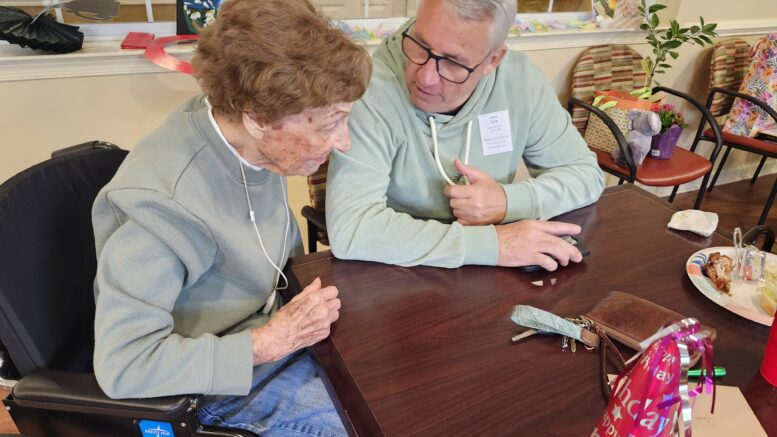Colorado has the second-fastest-aging population in America, and those between 65 and 74 years old are its fastest-growing demographic. Despite that, the number of assisted-living beds available in the state — particularly for lower-income adults — is declining.
Officials in the assisted-living sector, worried that the diverging supply and demand arcs will leave too many Coloradans without a place to age safely, say that state officials need to pay attention. And they specifically need to look at their current heavy regulations and slow-moving permitting and compliance mechanisms and ask if these rules and their enforcement are doing anything to make aging care more affordable or more accessible.
Legislators in recent days have debated two bills that seek to address the situation in very different ways. One recommends raising the minimum wage for direct-care workers from $17 to $25 over the next two years and has come under criticism from some industry leaders, while the other seeks to roll back regulations on senior-care facilities, among other provisions, and is being praised.
“Pricing people out of the market”
Regardless of whether Gov. Jared Polis signs both bills into law, however, the assisted-living sector will still face bed and staffing shortages in the near term, officials say, as costs of operating facilities grow significantly and shrink facility owners’ return on investment. In interviews with The Sum & Substance, several suggested state officials re-examine the growing and specific requirements they’re pushing on operators of smaller neighborhood care facilities and ask why fewer are willing to take Medicaid patients.
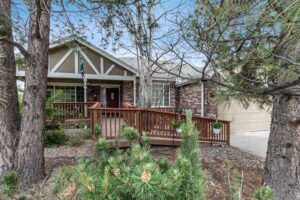
The exterior of a Colorado assisted-living facility operated by Assured Senior Living
“My ask would be: What are the objectives? Are we trying to make this more affordable?” said Francis LeGasse Jr., whose Assured Senior Living operates 32 assisted-living homes with about 300 residents in facilities that tend to house just eight to 12 people. “You’re pricing people out of the market. You’re pricing those who are born and raised and live in Colorado out of their home market or out of the places they want to be.”
LeGrasse acknowledged that having strict regulations can be both a blessing and a curse. It is imperative that the state do what it can to keep out of the market the bad actors who could take advantage of an incredibly vulnerable population, he said. But it also has to ensure it is welcoming enough to businesses to draw in the good providers who are desperately needed.
How assisted-living regulations increased
Between 2010 and 2020, the percentage of residents who are seniors in Colorado grew faster than all but one other state, according to statistics from the state demographer’s office. With that has come a growing need for direct-care workers, with the current pool of 59,000 needing to grow 27% in the next decade to keep up with demand, Colorado Fiscal Institute labor policy analyst Sophie Mariam told a Senate committee on Thursday.
Yet according to numbers provided by the Colorado Department of Public Health and Environment, the number of assisted-living beds shrank from 25,633 in November to 25,393 in April — a loss of 270 beds that included 205 for people paying through Medicaid. Some facilities serving Medicaid patients — those willing to take the public insurance program’s $3,750 monthly reimbursement that falls thousands of dollars short of covering needed expenses — report waiting lists stretching past two years, said Janet Cornell, president of the Colorado Assisted Living Association.
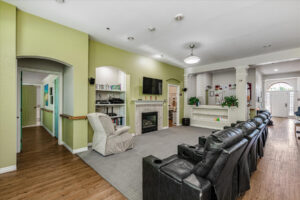
The TV room of an assisted-living facility operated by Assured Senior Living
In 2018, Cornell recalled, CDPHE updated rules for the industry, growing the number of pages of regulations from 49 to 81. The section on food safety went from one page to six and included requirements on the temperature the food needed to be served at and the speed at which meals needed to be cooled. The state also boosted training requirements, meaning small homes needed to spend more on getting new workers up to speed and more time making sure they kept their residences in compliance.
Cornell, like LeGasse, agrees that assisted-living homes must be held to high standards, particularly after a series of high-profile incidents at senior-living facilities a few years back that included a dementia-addled patient freezing to death when no one saw her go outside. But a 2022 law that raised maximum fines for regulatory violations from $2,000 per year to $10,000 per incident made some small facilities think again about whether they could afford to provide care and forced numerous others to stop offer Medicaid slots, she said.
Architectural requirements and slow inspection turnarounds
In 2018, the state also required assisted-living facilities to conform to Facilities Guideline Institute standards that determined the minimum size of bedrooms, windows, hallways and other areas — and were required to be met if homeowners proposed any structural changes or changes to capacity, like making a single-occupancy room into a double. Colorado is just one of two states that applied the standards to assisted-living facilities, industry attorney Michelle Pinkowski testified to a Senate committee, and for seven years they have served as an impediment to facility owners adding badly needed bads.

The bedroom of an assisted-living facility operated by Assured Senior Living
That, Pinkowski said in an interview, is because requesting to add even two beds to the eight-bad homes that are common statewide, would spur an intensive FGI review process that could require facility owners to invest heavily in updates for little financial gain. And even though the roughly 400 small-group homes in Colorado, often retrofits of old single-family homes, are designed differently than investor-backed assisted-living campuses, they were regulated similarly, financially disadvantaging smaller homes, she said.
Because CDPHE has a limited staff of inspectors, it often takes months for one to schedule a visit to determine if a facility meets FGI standards — delays that can be extra costly for smaller facilities waiting to get an OK before they can welcome residents and generate revenue, said Jim Flint, who leases assisted-living properties to operators. That makes operators less receptive to accepting lower-paying Medicaid patients to fill a limited number of beds, and it makes it harder to operate the smaller homes — which research has shown help to acclimate dementia patients — altogether, he said.
“You can only lose money for so long before you have to shut the doors and kick everyone out, or stop taking Medicaid, said Vern Harris, Flint’s fellow broker at A Better Way Realty. “It’s so difficult these days.”
The risk to Medicaid patients
No one seems sure exactly what happens to lower-income Medicaid recipients where there are not beds available to them in assisted-living facilities. Mariam testified that some must remain living with relatives, which can cause financial strain for their families and even force caretakers to leave the workforce. Cornell suggested others end up in higher-cost skilled-nursing homes when they don’t need such constant medical attention. It’s possible that some become homeless.
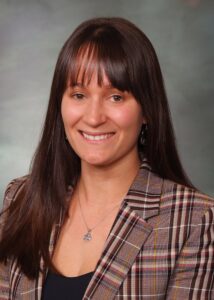
Colorado state Rep. Lisa Feret, D-Arvada
The industry appears it will be getting some relief this year from House Bill 1213, which makes several changes to state policies designed to ease regulation on Medicaid providers, who are getting just a 1.6% increase in compensation in next year’s budget. Maybe the most important provision eliminates the need for facilities to undergo through FGI compliance reviews when they seek to add beds without undertaking structural alterations — a provision that applied originally only to facilities with less than 19 beds but was expanded during the legislative process to include everyone.
“I know it doesn’t sound like big changes,” said Rep Lisa Feret, the Arvada Democrat cosponsoring the bill. “But these are huge changes to people who are in the trenches helping our Medicaid patients and our providers.”
The burden of assisted-living pay hikes
But sector leaders are concerned about how much that may be offset by HB 1328, which sought to mandate $25 hourly wages by 2028 for direct-care workers now earning $17.71 on average but later had that requirement changed to a recommendation. The bill, which passed the House and has cleared its first Senate committee, also implements mandatory training to explain to new sector workers their rights and creates an opt-in communications platform through which both unions and potential clients can reach them.
HB 1328 has been advancing on partisan, Democrat-led votes, and Cornell explained that even with the wage hike now just a recommendation, it’s raised issues about the state mandating a 32% increase in pay from the $17 hourly minimum it demands for direct-care contractors while boosting reimbursement just 1.6%. The result likely would be that assisted-living homes would require higher-paying customers, leaving Medicaid recipients with even fewer options for long-term care.
“Of course, we would love to have employees make 25 dollars an hour. But if you limit your Medicaid beds, what have you accomplished there?” she asked. “A Medicaid facility cannot pay 25 dollars an hour. If they raise Medicaid reimbursement to facilities, that’s great — then we can pay our employees. But that’s just not there.”
Leaders say other changes needed
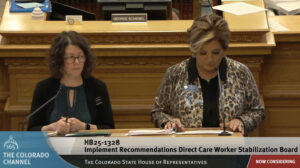
Colorado state Rep. Emily Sirota and House Majority Leader Monica Duran explain their House Bill 1328 to their chamber.
Further, state regulations make it difficult for workers to move from facility to facility without costly retraining, Cornell and others said. A law implemented last year was supposed to allow for simpler portability of training credentials, but state regulators have required portable certificates to list things like the worker’s proficiency, which most don’t, Cornell noted.
Industry leaders have suggestions.
Harris said Colorado needs to decrease its costs of licenses for new facilities, which he believes are the highest in the country, while Flint said inspectors should be paid per inspection, which would incentivize more efficient permitting. Pinkowski suggested CDPHE needs more resources to boost its staffing. LeGasse suggested it should get rid of the FGI standards altogether and focus only on safety in facility design.
None of the industry veterans wants regulations to go away, as all agree that protecting the vulnerable residents entrusted by their families to assisted-living facilities and direct-care workers is of paramount importance. But, as the small relief included in HB 1213 demonstrated, there are ways to balance regulation with realization that facilities need fewer adversarial actions and more partnership with the state to be able to expand to meet the needs of its aging population.
“We err on the side of such caution in causing harm that we overregulate,” LeGasse said. “At the end of the day, if we’re not mindful about these regulations, we are going to limit who we can support in the aging journey.”
